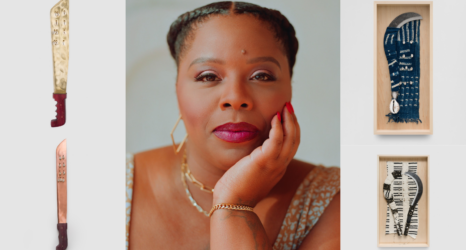Ms. August
Downstream in August, down the heron flew,
straight through the secret bower where we stay
in ferny waterfalls, safe from the day,
forgotten as her words, a fonds perdu.
A “girlie calendar” makes one think of men’s lockers, walls of auto repair shops or a military barracks: They’re typically collections of nude or scantily dressed women in provocative poses, designed for the male heterosexual gaze.
But what if a girlie calendar is designed with a lesbian gaze in mind? That sort of subversion is what lesbian poet Mary Meriam has in mind with the title of her poetry collection, Girlie Calendar, and for the Ms. Blog she is excerpting from the book a poem-of-the-month (she began in October and continued in November, December, January, February, March, April May, June and July). Meriam is also selecting accompanying artwork for each month from both historical and contemporary lesbian-related images.
Ellis Avery, author of The Last Nude—about the affair between this month’s artist and the Ms. August model—writes below about Tamara de Lempicka’s enduring work.
Born in Warsaw in 1898, painter Tamara de Lempicka hit her peak in Paris between the wars, when her gleaming, stylized portraits were in such high demand that she made her first million dollars before the age of 30. Both her name and her Cubist-influenced interwar work became synonymous with the sleek, metallic curves of Art Deco. Married twice, she had a daughter, Kizette, with her first husband. Her interwar paintings include a number of images of pairs or groups of women engaged in lesbian activity.
The young woman in this painting served as model for six of de Lempicka’s paintings, among them “Beautiful Rafaela,” lauded by London’s Sunday Times as “One of the most remarkable nudes of the 20th century.”
At the Royal Academy exhibition where I first encountered “Beautiful Rafaela,” I was startled to read, right there on the wall, in prim curatorial type, that in 1927, while in the throes of a bitter divorce, de Lempicka met this model on a walk in the Bois de Boulogne and drove her home: Rafaela became her model and her lover, and their relationship lasted for a year.
This is what de Lempicka had to say about that first Bois du Boulogne encounter with the woman depicted in this painting, according to her daughter, Kizette Foxhall de Lempicka:
“Suddenly,” Tamara would say, “I become aware of a woman walking some distance in front of me. As she walks, everyone in the opposite direction stops and looks at her. They turn their heads as she passes by. I am curious. What is so extraordinary that she is doing this? I walk very quickly until I pass her, then I turn around and come back down the path in the opposite direction. Then I see why everyone stops. She is the most beautiful woman I have ever seen—huge black eyes, beautiful sensuous mouth, beautiful body. I stop her and say to her, ‘Mademoiselle, I’m a painter and I would like you to come pose for me. Would you do this?’ She says, ‘Yes, why not?’ And I say, ‘Yes, come. My car is here.’
“I took her home in my car, we had lunch, and after lunch, in my studio, I said, ‘Undress, I want to paint you.’ She undressed without any shame. I said, ‘Lay down on this sofa here.’ She lay. Every position was art—perfection. And I started to paint her, and I painted her for over a year.”
Even without the erotic autobiographical tale of cruising in a public park, this painting invokes a lesbian gaze: the female painter represents Ms. August’s perfect breasts and lush belly not as gravity would let them droop, but as an erotic imagination would hold them aloft.
At the same time, this painting of a gloriously voluptuous half-naked woman subverts the girlie calendar because it gestures toward a lived reality that’s in excess of its model’s gorgeous body: Ms. August’s slightly disordered hair seems damp with real perspiration, her distorted cheek and eye, squished up against her arm, suggest true fatigue rather than posed languor, and her half-closed lids and sarcastic expression speak to the mind-numbing boredom of being an artist’s model. There are two women in this hot room, this painting says to me, and they’re both working.
About Ellis Avery: The only writer ever to have received the American Library Association Stonewall Award for Fiction twice, Ellis Avery is the author of four books, among them The Last Nude, about the affair between Tamara de Lempicka and the young woman who modeled for Ms. August. Avery’s work has also received Lambda, Ohioana, and Golden Crown awards, and has been translated into six languages. She teaches fiction writing at Columbia University and edits Public Streets, an urban observations column on the Public Books website.
Painting reproduced with permission from the Lempicka Estate
© 2015 Tamara Art Heritage. Licensed by MMI/NYC.
Poet Mary Meriam is the founder of Lavender Review, cofounder of Headmistress Press and author of The Countess of Flatbroke, The Poet’s Zodiac, Word Hot, Conjuring My Leafy Muse and Girlie Calendar.





